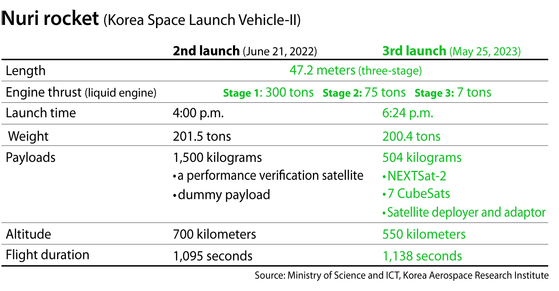![The Korea Space Launch Vehicle (KSLV-II), or Nuri, takes off from the launch pad at the Naro Space Center in Goheung County, South Jeolla, at 6:24 p.m. on Thursday. [YONHAP]](https://koreajoongangdaily.joins.com/data/photo/2023/05/25/409ee7e7-d9a7-45e8-837d-868ff8172338.jpg)
Korea’s domestically developed space rocket Nuri took off from its launch pad on Thursday, carrying a so-called “practical satellite” to a target altitude of 550 kilometers (342 miles) above ground.
Out of a total of eight payloads, seven of them successfully separated from the carrier, with one subject to further evaluation, according to Science Minister Lee Jong-ho in a press briefing Thursday.
“We couldn’t confirm visually because the sixth CubeSat was in a blind spot,” said Lee. “But that does not mean that the payload failed to be released from the carrier because the seventh payload was properly released, but we will confirm the matter later.”
This is the third launch of the Nuri rocket, formerly known as the Korea Space Launch Vehicle-II, and the carrier rocket’s first attempt to bring a practical satellite into mission orbit.
Therefore, the latest liftoff represents the Nuri rocket’s shift from the testing phase to operational deployment and performance refinement.
The milestone followed the previous two test launches in October 2021 and June 2022.
With the success of the second launch on June 21 last year, the Korea Aerospace Research Institute (KARI) became the seventh space agency to succeed in putting a satellite weighing more than 1 ton into space, following Russia, the United States, the European Union, China, Japan and India.

On Thursday, the three-stage, liquid-fueled Nuri rocket blasted off from its launch pad at 6:24 p.m.(KST), carrying a payload of 1,111 pounds (504 kilograms), including a domestically developed practical satellite.
The carrier rocket’s mission is to deploy a total of eight satellites into a solar synchronous orbit circling the earth at an altitude of 550 kilometers.
The first stage booster, fitted with four 75-ton liquid fuel engines, separated 125 seconds after the launch at an altitude of 64.5 kilometers. A cover surrounding the payloads was split off after 234 seconds at an altitude of 204 kilometers.
When 272 seconds passed, the second-stage booster, equipped with a 75-ton liquid fuel engine, separated at an altitude of 258 kilometers.
The first and also main satellite separated from the third stage 783 seconds after liftoff, at the targeted altitude of 550 kilometers. The rest of the payload, seven small-sized cube satellites (CubeSats), were separated one-by-one at intervals of 20 seconds.
For the satellites, the Science Ministry plans to announce whether the payloads successfully entered their target orbits on Friday morning, based on the communicated data.
While the specification of the Nuri rocket remained largely the same from previous test launches, the weight and number of payloads the space vehicle carried into suborbital space differed this time.
The Nuri rocket had to handle eight payloads respectively during the latest launch, unlike the previous mission in which the rocket carried just two payloads, including one dummy satellite.
The main payload was the Next Generation Small Satellite 2, or NEXTSat-2, described by the Ministry of Science and ICT as the first “commercial-grade satellite” aboard the Nuri rocket.
The 179.9-kilogram NEXTSat-2, developed by the Satellite Technology Research Lab at KAIST, is equipped with a small-sized synthetic aperture radar that can capture high-resolution images regardless of weather conditions.
If the NEXTSat-2 successfully enters the targeted orbit, the satellite will carry out its two-year missions, which include monitoring the cosmic radiation in the low earth orbit.
Also on board the Nuri rocket were seven CubeSats, developed by Justek, Lumir, Cairo Space and Korea Astronomy & Space Science Institute.
In the second test launch last year, the Nuri rocket carried a 1,500-kilogram payload, including a performance verification satellite, four CubeSats and a dummy payload. As the small-sized CubeSats were placed inside the performance verification satellite during the second launch, the latest launch on Thursday was the Nuri rocket’s first attempt at deploying multiple satellites with the vehicle.
Another noteworthy difference from the previous launch is that the latest liftoff took place more than two hours later than the second test launch in June last year.
The adjustment in the launch time aimed to bring NEXTSat-2, the main payload, into the targeted orbit, which could only be done at sunset when the satellite can face the sun and therefore secure enough solar energy to power its radar for the mission.
Another major difference from the previous launch is that a private company participated in the launch operation for a public-private technology transfer.
In December last year, Hanwha Aerospace signed a $217 million (286-billion-won) contract with KARI to run the Korea Space Launch Vehicle Advancement Program. The Korea Space Launch Vehicle Advancement Program aims to improve the Nuri rocket through repeated launches with an estimated budget of 687.4 billion won through 2027.
Three more launches are scheduled until 2027.
BY LEE JAE-LIM, SHIN HA-NEE [lee.jaelim@joongang.co.kr]




